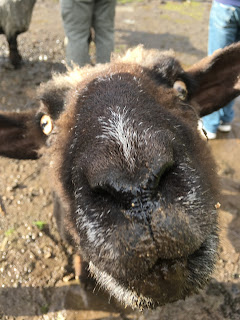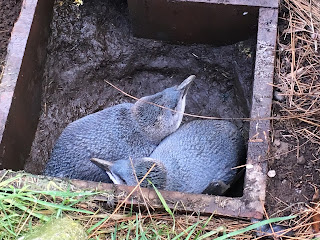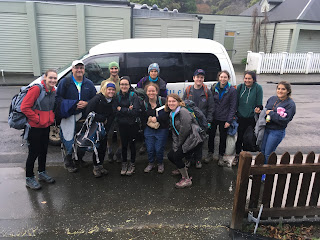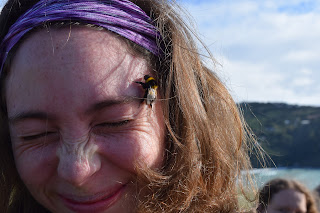The day started out at 9:20 am in a chilly 40*F as we all filed into the Gatorwaka with our lunches, rain jackets, and hiking boots. We waved goodbye to The Annex (our home here in New Zealand) and began our adventure for the day. Passing by freshly sheered sheep, little ponies, and tubby cows, we made our way to Akaroa about an hour away, where we were going to kayak with Pohatu Pengin Tours. Excitement began to rise as we stopped about half way to Akaroa at the Little River Cafe for morning tea time. After warming our bellies, we made it to Akaroa to meet Kevin, our guide for the day. We then piled into two separate vans and went up and over a nearby mountain, giving us a good view of Akaroa Harbour.
An artsy photo of us on top of the mountain with Akaroa Harbor in the background covered in cloud as we began to make our way to the kayaks.
Kevin stopped the van along the way to Flea Bay to check for tree wetas, and look, we found one! This is a female and was about the size of a pointer finger. Those little geckos are baby common geckos (super cute in my opinion)!
We made it to the reserve! As soon as we got out, we began making friends with the resident sheep.
Look at this handsome fella!
Ali in the front, Jaam (mid-right), Dr. Hostetler (mid-left) and a little bit of Kevin in the back with his green Kayak leading the way and warning us not to bark at the seals! We also saw penguins on the rocks and swimming in the beautiful blue glacier water!
This little guy, which some of us named Ferdinand, was there before and after our kayaking adventure!
After changing into a set of dry clothes, we gathered around Kevin to learn some more facts about the Little Blue Penguins, being careful not to slip and fall in sheep poo!
This is one of the estimated 1,300 mating pairs of penguins in the area. Every mating season, the pair-bonded couple returns to the same nest to raise more chicks!
From left to right: Ali, Dr. Hostetler, Tatiana, Kevin, Erika, Anna, Marta, Savannah, Sean, Allison, Isabella and Camilla!
With our arms tired, feet cold, and boots covered in mud, we thanked Kevin for the wonderful tour and made our way down the street for a warm cup of coffee/tea/hot chocolatete before heading out to go back to the Annex. Everyday is an adventure here, today was extra special fun, now what adventure will we have tomorrow?
~Savannah





















































